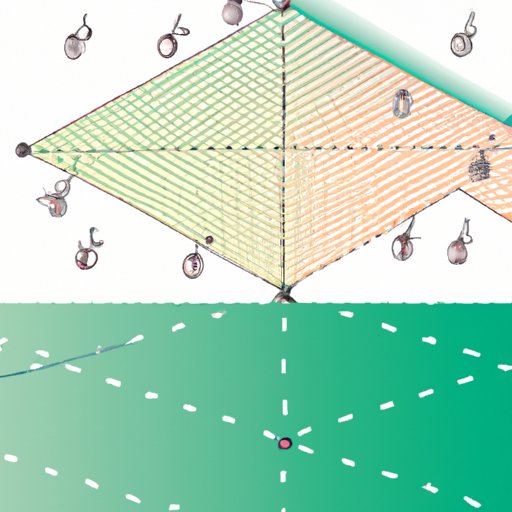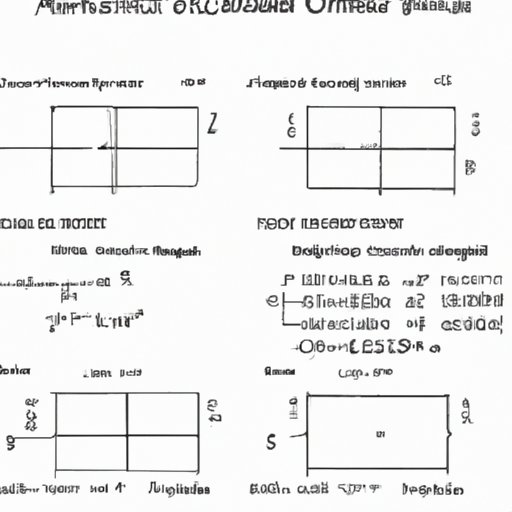
How to Calculate Surface Area: A Comprehensive Guide
Surface area is the measure of how much surface an object has. It is the sum of the areas of all faces, shapes, and surfaces that make up an object. Understanding how to calculate surface area is crucial not only in math, but in many professions such as architecture, biology, and engineering. In this article, we will discuss the step-by-step process of calculating surface area, formulas and examples, the importance of surface area in different fields, how surface area affects our everyday lives, common mistakes to avoid in surface area calculations, and fun and interactive ways to learn about surface area.
A Step-by-Step Guide for Calculating Surface Area
To start, it is important to understand the definition of surface area. Surface area is the measure of the total area that the surface of an object occupies. In other words, it is the sum of all the areas of the faces of a 3D object.
The formula for finding the surface area of an object depends on the shape of the object. The following is a list of formulas for several common shapes:
– **Rectangular Prism:** Surface Area = 2lw + 2lh + 2wh
– **Cube:** Surface Area = 6s² (where s is the length of a side)
– **Sphere:** Surface Area = 4πr² (where r is the radius)
– **Cylinder:** Surface Area = 2πr² + 2πrh
– **Pyramid:** Surface Area = (base × height) ÷ 2 + (base × slant height ÷ 2)
To calculate the surface area of an object, follow these steps:
1. Identify the shape of the object.
2. Write down the formula for that particular shape.
3. Measure the relevant dimensions of the object (length, width, radius, height, etc.).
4. Substitute the measured dimensions into the formula.
5. Simplify and calculate the equation.
It’s important to note that when measuring dimensions, it is best to use the same units for each measurement (e.g. inches or centimeters).
Let’s say we want to calculate the surface area of a rectangular prism that has a length of 5 inches, a width of 3 inches, and a height of 2 inches. Using the formula for a rectangular prism:
Surface Area = 2lw + 2lh + 2wh
Surface Area = 2(5)(3) + 2(5)(2) + 2(3)(2)
Surface Area = 30 + 20 + 12
Surface Area = 62 square inches
In this example, the surface area of the rectangular prism is 62 square inches.

Surface Area Formulas and Examples
In addition to the formulas mentioned in the previous section, there are several other formulas that can be used to calculate surface area based on the shape of the object. For example:
– **Triangle:** Surface Area = (½ × base × height)
– **Regular Prism:** Surface Area = (½ × perimeter of the base × height) + (2 × base area)
– **Cone:** Surface Area = πr(r + s) (where s is the slant height)
– **Torus:** Surface Area = 4π²Rr (where R is the distance from the center of the torus to the center of the tube, and r is the radius of the tube)
To demonstrate, let’s use the formula for a cone to calculate the surface area of a traffic cone that has a radius of 7 inches and a slant height of 10 inches.
Surface Area = πr(r + s)
Surface Area = π(7)(7 + 10)
Surface Area ≈ 274.89 square inches
So the surface area of the traffic cone is approximately 274.89 square inches.
It’s helpful to note that depending on the shape of the object, certain formulas may work better than others.
The Importance of Surface Area in Different Fields
Surface area plays a crucial role in many professions, including architecture, biology, and engineering. In architecture, surface area is used to determine the amount of insulation needed for a building, as well as the amount of materials needed for walls and roofs. In biology, surface area is important in the respiratory and digestive systems, where it affects the rate of gas and nutrient exchange. In engineering, surface area is used to determine the amount of heat transfer that occurs within a system.
Here are some specific examples:
– In architecture, calculating surface area is used to determine the amount of insulation needed to maintain a consistent temperature inside a building. This helps to reduce energy consumption and lower heating and cooling costs.
– In biology, the surface area of villi in the intestine and alveoli in the lungs allows for efficient absorption of nutrients and oxygen. Increasing surface area allows for a more efficient exchange of gases and nutrients, which is essential for cellular respiration.
– In engineering, surface area plays a role in designing heat exchangers, which use material with a large surface area to exchange heat between two fluids at different temperatures. The larger the surface area, the more efficient the heat transfer.
Surface Area in Everyday Life
Understanding surface area can also be helpful in everyday tasks. For example, calculating surface area can help determine the amount of paint needed to cover the walls of a room or the amount of tile needed to cover a floor. It can also help in cooking when determining the surface area of a baking dish or the amount of frosting needed to cover a cake.
Additionally, understanding surface area in everyday life can help individuals make more informed decisions. For example, someone may be able to save money on their heating and cooling bills by properly insulating their home based on the surface area calculations.
Common Mistakes to Avoid When Calculating Surface Area
Like with any calculation, there are common errors that can be made when calculating surface area. One common mistake is to forget to include all of the faces of an object. For example, the surface area of a rectangular prism would be calculated incorrectly if only two sides were measured. Additionally, mistakes can be made when using the wrong formula or using incorrect units when measuring dimensions.
To avoid these common mistakes, take your time and double check your measurements. Make sure to verify that you have the correct formula before calculating the surface area.
Fun and Interactive Ways to Learn About Surface Area
There are several videos, games, and online simulations that can make learning about surface area more engaging and fun. The following are a few examples:
– **Khan Academy**: Khan Academy offers an entire section on geometry that covers surface area. It includes videos, exercises, and practice tests.
– **Scratch**: Scratch offers a free, interactive game called “Surface Area Golf” in which players choose the angle and velocity of an object to land it on a surface with the least amount of surface area.
– **GeoGebra**: GeoGebra offers an online surface area calculator that allows users to input the dimensions of an object and calculates the surface area in real time.
Conclusion
In conclusion, surface area is an important concept that plays a role in many different fields and everyday tasks. In this article, we covered the step-by-step process of calculating surface area, various formulas and examples, the importance of surface area in different fields, how it affects our daily lives, common mistakes to avoid, and fun and interactive ways to learn about it. By understanding surface area, we can have a better appreciation for its applications and empower ourselves in making more informed decisions.





